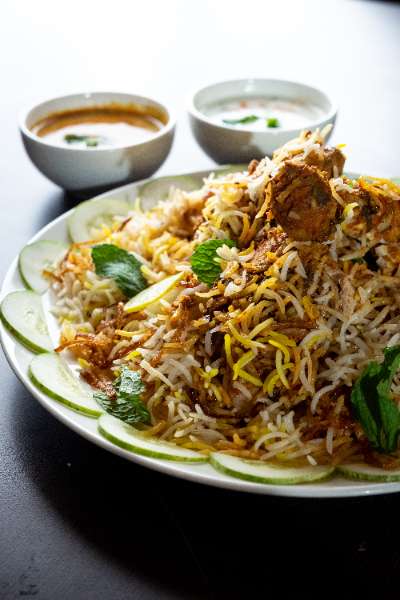In general, there are two types of Biryani – the Kutchi (raw) biryani and the Pukki (cooked) biryani.
In Kutchi biryani, the meat is layered with raw rice in a handi (a thick bottomed pot) and cooked, while in Pukki biryani cooked meat and rice are layered in the handi, where they come together in a marriage of flavours.
The evolution of biryani spans many centuries, many cultures, many ingredients and many cooking styles. From an army dish to a dish fit for royalty, the biryani today is a pan-India culinary favourite. Its many varieties reflect the local tastes, traditions and gastronomic histories of their regions of evolution. Here are some lip-smacking regional variants that every biryani lover should know about.
1. Mughlai Biriyani

The Mughal Emperors were very fond of lavish dining experiences and looked upon cooking as an art. The regal Mughlai biryani fit the bill perfectly. Succulent chunks of perfectly spiced meat, enveloped in kewra scented rice, emanate an irresistible aroma that makes one hungry instantly. This biryani definitely smells and tastes royal !
2. Hyderabadi Biriyani

The world-famous Hyderabadi Biryani came into being after Emperor Aurangzeb appointed Niza-Ul-Mulk as the new ruler of Hyderabad. His chefs reportedly created almost 50 different versions that used fish, shrimp, quail, deer, and even hare meat. While most other biryanis are dominated by their flavoured meat, in the layered Hyderabadi biryani, the aromatic saffron flavoured rice is the star of the dish. Hyderabad was also the place where the Kacchi Akhni Biryani was fine tuned and perfected.
3. Calcutta Biryani

Banished by the British, the legendary gourmet Nawab Wajid Ali Shah tried to recreate his beloved dish in the city of Calcutta. Unable to afford meat due to budget constraints, the local cooks gave the recipe a tweak, replacing meat with perfectly cooked golden brown potatoes – the signature of the Calcutta biryani. Much lighter on spices, this biryani primarily uses a yoghurt based marinade for the meat, which is cooked separately from the light yellow rice. Also, just like most Bengali dishes, the Calcutta biryani has a hint of sweetness hidden in it.
4. Dindigul biryani

A much-loved local favourite, Chennai has many outlets dedicated to serving just the Dindigul biryani. The jeera samba rice used in making this biryani is distinctive and gives it an entirely different flavour. Also, instead of large chunks of meat, Dindigul biryani uses tiny cube-sized meat pieces. Curd and lemon lend the biryani its tangy taste, while the liberal use of pepper leaves its fiery mark on the palate.
5. Lucknowi biryani

Cooked in the royal Awadhi style, the textures of Lucknowi biryani are softer and the spices milder. The first step involves making a yakhni stock from meat that is slow boiled in water infused with spices for about two hours or more. This is the reason why this biryani is more moist, tender and delicately flavoured than other biryanis.
6. Arcot Biryani

Introduced by the Nawabs of Arcot, this biryani originated in the towns of Ambur and Vaniyambadi in the Vellore district of Tamil Nadu. The biryani is generally accompanied by dalcha (a sour brinjal curry) and pachadi (a type of raita). The best known sub-variety of the Arcot biryani is the Ambur biryani that uses the squat seeraga samba rice, a traditional Tamil Nadu variety.
7. Memoni Biryani

Similar to the Sindhi biryani, this extremely spicy variety is made by the Memons of the Gujarat-Sindh region. Usually made with lamb, yoghurt, browned onions and potatoes, Memoni biryani uses less food colouring compared to other biryanis. This allows the natural colours and flavours of the various components- meat, rice and vegetables – to emerge and shine in this traditional dish.
Source: thebetterindia.com



































